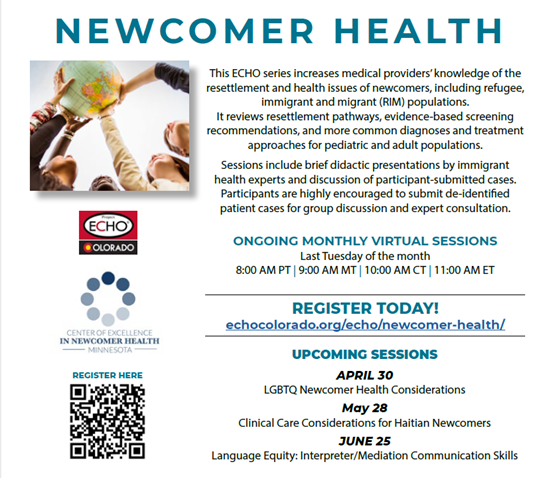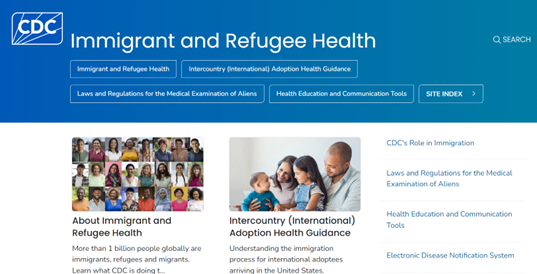|
World Refugee Day is an international day designated by the United Nations to honor refugees around the globe. Every June 20, communities around the world honor and celebrate the over 36.4 million refugees who have been forced to flee their home due to conflict and persecution. Various activities will be held across the U.S. to support refugees joining our communities and we encourage you to participate in an event close to you.
For this upcoming World Refugee Day, we want to hear from you. Contribute to our World Refugee Day reflections from the field. We will feature a word cloud in our July newsletter, celebrating all our readers who contribute to refugee health.
In one word, why is welcoming newcomers important to you?
Please submit your answer at World Refugee Day Slido Word Cloud!
Our COE partners have recently published an article:
COVID-19 Vaccine Uptake Among Non-US-Born Populations in the United States, 2020-2022
Margaret B. Nolan, Ella Chrenka, Patricia Walker, Abigail Steiner, Kristine Knuti Rodrigues, Jeremy J. Michel, Katherine Yun, Colleen Payton, Janine Young, Blain Mamo, Mateo Frumholtz, Malini DeSilva, COVID-19 vaccine uptake among non-US-born populations in the United States, 2020–2022, Vaccine, Volume 42, Issue 12, 2024, Pages 3115-3121, ISSN 0264-410X.
Highlights include:
- In the United States (US), COVID-19 vaccination rates among non-US-born individuals are variable but understanding them is critical to identifying disparities.
- Among over 1.5 million patients eligible for COVID-19 vaccination at 4 health systems across the US, completion of the primary vaccination series was lower in patients with a language preference other than English (62.7%) compared with English preferring patients (63.6%).
- Though completion of the primary series was higher for non-US-born persons compared with US-born persons, completion of a booster dose was lower for non-US-born persons, refugees, and patients with a language preference other than English compared with their counterparts.
- Requirements for COVID-19 primary vaccination for entry into the US may have played a role in the higher completion of primary COVID-19 series vaccines among refugee, immigrant and migrant populations.
- The lower rate of booster uptake among newcomer populations is worthy of further attention.
In partnership with ECHO Colorado, the Minnesota Center of Excellence in Newcomer Health has been hosting a monthly training on newcomer health since Oct. 25, 2022.
Register for the 2024 series on the ECHO Colorado Website! Please note that ECHO has a new website, so you may need to clear your internet history/cache before registering.
Sign up for the ongoing monthly ECHO sessions held virtually:
ECHO Colorado: Newcomer Health
Last Tuesday of each month
11 a.m. ET | 10 a.m. CT | 9 a.m. MT | 8 a.m. PT
Refer to Connect Troubleshooting Tips (PDF) if you have issues registering, joining, etc.
Promotional flyer: ECHO Colorado: Newcomer Health (PDF)
Access resources and previous sessions: Newcomer Health ECHO Resource Page

North American Refugee Health Conference
The 2024 North American Refugee Health Conference will be held in Minneapolis, Minnesota on Aug. 5-7, 2024. Register for the NARHC Conference now!
NARHC pre-courses
- NARHC will be hosting three pre-courses this year on Aug. 4 from 9 a.m. to 5 p.m. The "Afghan Women’s Health" and "Introduction to U.S. Refugee Health" courses will be free. Learn more about these courses and register online at NARHC Pre-Courses.
- There will be an additional pre-course hosted by the University of Minnesota Global Medicine, “Practical Parasitology for Refugee Health Clinicians: All the parasites we can fit in one day!” It will offer CME and cost $249 USD.
Learn more about the course: Practical Parasitology for Refugee Health Clinicians Flyer (PDF).
Vaccination Technical Instructions for Panel Physicians
On April 19, 2024, CDC updated the Vaccination Technical Instructions for Panel Physicians and the Addendum to Technical Instructions for Vaccinations: Polio with additional details.
The following key updates are included in Table 1: Vaccine Requirements According to Applicant Age for Panel Physicians of the technical instructions:
- Tdap/Td for ages 11 years and older: This now includes both the routine age-based recommendation (1 dose Tdap, then Td or Tdap every 10 years) and the catch-up vaccine recommendations for adults who have not completed the primary vaccination series for tetanus, diphtheria, or pertussis (1 dose Tdap followed by 1 dose Td or Tdap at least 4 weeks later, and a third dose of Td or Tdap 6–12 months later).
- Age-based poliovirus vaccination: This now applies to all applicants aged 2 months or older to align with new Advisory Committee on Immunization Practices (ACIP) recommendations for adults who have not yet completed the primary vaccine series (3 dose series with at least 4 weeks between dose 1 and 2 and 6 months between dose 2 and 3). Additionally, only inactivated poliovirus vaccine (IPV) should be used to meet the standard, age-based poliovirus vaccination requirements for all ages. Bivalent oral poliovirus vaccine (OPV) should only be used as part of the Polio Addendum.
- Pneumococcal vaccination for those aged 65 years or older: Table 1 simply reads “YES” for this age group to clarify that all routine vaccination recommendations apply to this age group, which can vary by vaccination history. Learn more at Adult Immunization Schedule Notes: Pneumococcal vaccination.
Please reach out to PanelPhysicians@cdc.gov if you have any questions.
New CDC.gov
The Immigrant and Refugee Health Branch at the CDC has updated their website!
Take a moment and explore their easy-to-navigate pages:
Don’t forget to bookmark the new pages, since the URLs have changed.
As a reminder, the Key Clinical and Cultural Considerations for the Domestic Medical Screening and Newcomer Health Profiles have found a new home on the MN COE website.

Ukrainian Eligibility Update
On May 7, 2024, the Office of Refugee Resettlement (ORR) revised Policy Letter 22-13: Ukrainian Humanitarian Parolees Eligible for ORR Benefits and Services. This policy letter extends the period of eligibility for ORR benefits and services for eligible Ukrainian parolees to Sept. 30, 2024.
On May 9, 2024, ORR issued Policy Letter 24-01: Continued Services for Humanitarian Parolees from Ukraine with a Pending Re-Parole Application. This policy letter allows ORR grant recipients to continue to provide ORR benefits and services to certain humanitarian parolees from Ukraine who have a pending or approved re-parole application. Read the letter for more information regarding eligibility, the verification process, exceptions, and requirements if an individual’s re-parole application is denied.
MDH has updated its Ukrainian Clinical Guidance webpage to align with these changes.
Take a moment and review some recent publications on newcomer health:
- Tasslimi A, Bell TR, Moore TP, DeBolt C, Ibrahim A, Matheson J. Vaccine Coverage at 36 Months and 7 Years by Parental Birth Country, Washington State. Pediatrics. 2024 May 22:e2023064626. doi: 10.1542/peds.2023-064626. Epub ahead of print. PMID: 38774987.
- Mitchell CL, Kennar A, Vasquez Y, et al. Notes from the Field: Increases in Imported Malaria Cases — Three Southern U.S. Border Jurisdictions, 2023. MMWR Morb Mortal Wkly Rep 2024;73:417–419. doi: 10.15585/mmwr.mm7318a2.
- Liu Y, Posey DL, Weinberg MS, Phares CR. Tuberculosis in United States-Bound Follow-to-Join Asylees, 2014-2019. Am J Trop Med Hyg. 2024 Mar 26;110(5):999-1005. doi: 10.4269/ajtmh.23-0233. PMID: 38531107; PMCID: PMC11066364.
- Hernandez M, Perry GH. Latiné immigrant heterogeneity: Striking health differences among Cuban refugee/migration waves to the United States. medRxiv [Preprint]. 2024 Apr 19:2024.04.17.24305856. doi: 10.1101/2024.04.17.24305856. PMID: 38699377; PMCID: PMC11065033.
- Erdmann S, Jahn R, Rohleder S, Bozorgmehr K. Overcoming denominator problems in refugee settings with fragmented electronic records for health and immigration data: a prediction-based approach. BMC Med Res Methodol. 2024 Apr 1;24(1):81. doi: 10.1186/s12874-024-02204-7. PMID: 38561661; PMCID: PMC10983725.
- Garfein RS, Liu L, Cepeda J, Graves S, San Miguel S, Antonio A, Cuevas-Mota J, Mercer V, Miller M, Catanzaro DG, Rios P, Raab F, Benson CA. Asynchronous Video Directly Observed Therapy to Monitor Short-Course Latent Tuberculosis Infection Treatment: Results of a Randomized Controlled Trial. Open Forum Infect Dis. 2024 Mar 26;11(4):ofae180. doi: 10.1093/ofid/ofae180. PMID: 38665171; PMCID: PMC11045025.
|